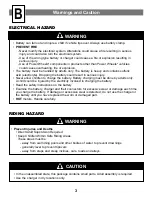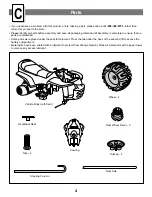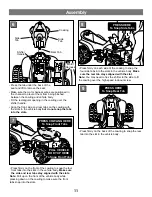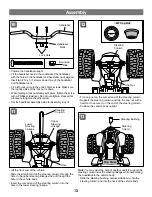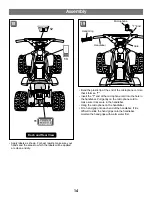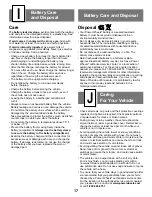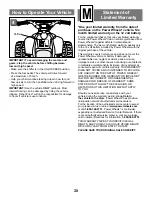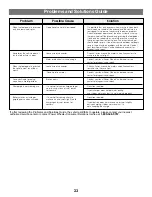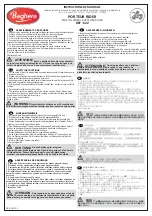
If a battery leak develops, avoid contact with the leaking
acid and place the damaged battery in a plastic bag. See
information below for proper disposal.
If acid comes in contact with skin or eyes, flush with
cool water for at least 15 minutes and call a physician.
If acid is internally ingested, give water, milk of
magnesia or egg whites immediately. Never give emetics
or induce vomiting. Call a physician.
• Charge a new battery for at least 18 hours before first
use. Never charge the battery longer than 30 hours.
Overcharging or undercharging the battery may
shorten battery life and decrease vehicle running time.
• After the first charge, recharge the battery for at least
14 hours after each use. Never charge the battery longer
than 30 hours. Charge the battery after each use,
regardless of how long the vehicle was used.
• The battery must be upright while charging.
• Do not allow the battery to run down completely
before charging.
• Charge the battery before storing the vehicle.
• Charge the battery at least once per month, even if
the vehicle has not been used.
• Leaving the battery in a discharged condition will
ruin it.
• Always remove an exhausted battery from the vehicle.
Battery leakage and corrosion can damage the vehicle.
• Do not store the battery on a surface which could be
damaged by the acid contained inside the battery.
Take precautions to protect the surface (such as kitchen
counter tops) on which you store the battery.
• Do not store the battery in temperatures above 75° F
or below -10° F.
• Prevent the battery from moving freely inside the
battery compartment. Always use the battery clamp
to secure the battery in the battery compartment.
• Examine the battery, charger and their connectors for
excessive wear or damage each time you charge the
battery. If damage is detected, do not use the charger
or the battery until you have replaced the worn or
damaged part.
• Your Power Wheels
®
battery is a sealed lead-acid
battery. It must be recycled or disposed of in an
environmentally sound manner.
• Do not dispose of a lead-acid battery in your regular,
household trash. The incineration, landfilling or mixing
of sealed lead-acid batteries with household trash is
prohibited by law in most areas.
• Do not dispose of a lead-acid battery in a fire. The
battery may explode or leak.
• Return exhausted batteries to a federal or state
approved lead-acid battery recycler, such as a Power
Wheels
®
authorized service center, or a local seller of
automotive batteries. For the service center location
nearest you, please call 1-800-348-0751. Contact your
local waste management officials for other information
regarding the environmentally sound collection, recycling
and disposal of lead-acid batteries. If you live in the
State of Florida or Minnesota, it is prohibited by law for
anyone to throw away lead-acid batteries in the
municipal waste stream.
Care
Disposal
Battery Care
and Disposal
I
Battery Care and Disposal
Caring
For Your Vehicle
J
• Check all screws, cap nuts and their protective coverings
regularly and tighten as required. Check plastic parts on
a regular basis for cracks or broken pieces.
• During snowy or rainy weather, the vehicle should be
stored inside or under a protective cover. Remember to
charge the battery at least once per month while your
vehicle is not in regular use.
• Avoid operating the vehicle in wet or snowy conditions,
and do not spray the vehicle with a hose. Do not wash
the vehicle with soap and water. Water or moisture in the
motors or electrical switches can cause them to corrode,
and could cause switch or motor failure.
• Avoid operating the vehicle on sand, loose dirt or gravel.
Sand, loose dirt or gravel in the motors or electrical
switches can cause them to jam, and could cause switch
or motor failure.
• The vehicle can be wiped down with a soft, dry cloth.
For a shiny finish, you can wipe plastic parts with a
non-wax furniture polish applied to a soft-cloth. Do not
use automotive wax. Do not use soap and water or spray
the vehicle with a hose.
• To ensure that your vehicle stays in good operating order,
we recommend that you periodically have your vehicle
checked by a Power Wheels
®
authorized service center.
For the location of the authorized service center nearest
you, please visit us on-line at www.powerwheels.com
or call 1-800-348-0751.
17

